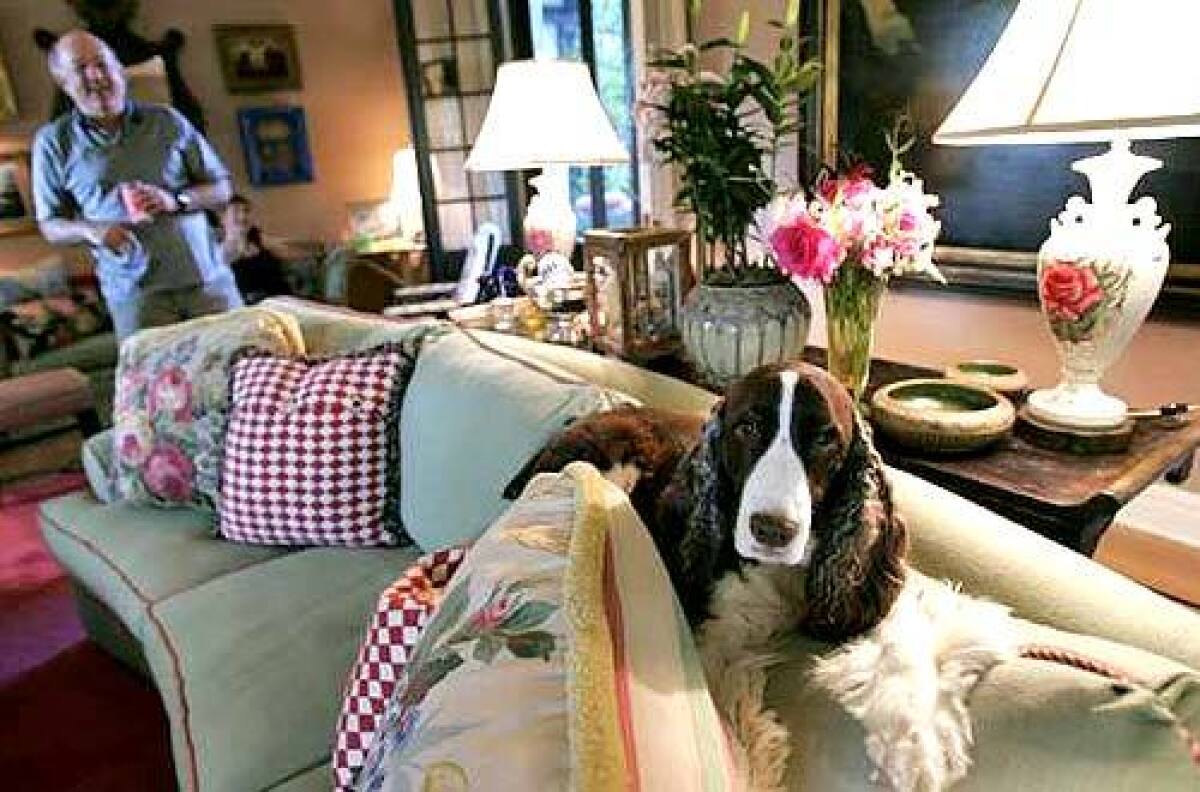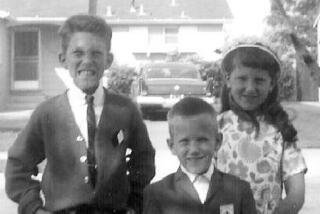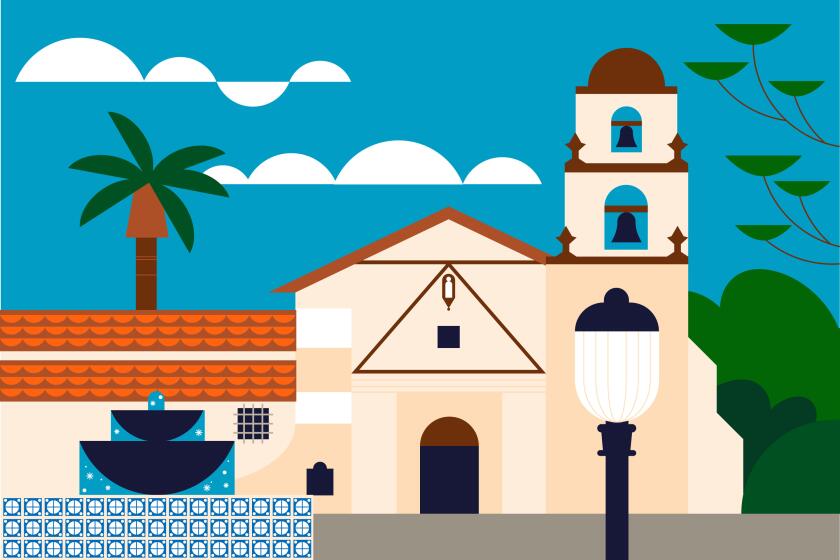A throwback that’s a step forward

Lunch was long over, the conversation lingered, and Alice’s patience was wearing skittishly thin. A girl couldn’t wait all afternoon. At last the guest stood from the dining table to leave, but not just yet, please, journalist and photographer Jamie Wolf requested, not before the neatly coiffed springer spaniel did her “jobs” — she had trained to become a therapy dog in hospitals and she needed to go to work.
A choreographed performance involving tricks and treats followed in the kitchen, all a build-up to the grand finale: Alice’s piano recital. As Wolf squirted Cheez Whiz across the keys of a child’s piano, the spaniel lapped it up left and right to produce a zany atonal sound not unlike a John Cage composition.
Welcome to Jamie and David Wolf’s world: tradition, entertainingly tweaked. It’s not what you’d likely imagine given the luxe Beverly Hills address and a cursory look around the flower-laden grounds and the refined public areas of the 18-room, 1927 Normandy-style house. But in no time flat you get a whiff of something slightly edgy and off-center in this otherwise comme il faut environment — a throwback to the comely decorum of the ‘40s and ‘50s — with its floral wallpapers, its fragrant bouquets of roses and dahlias, its multiple seating areas of plush, patterned upholstery, its pink and green striped umbrellas shading patios and poolside.
What an unabashed pleasure to find oneself surrounded by these enveloping comforts in an era of pared-down austerity. How unfamiliar it feels, but how right, how strangely new, somehow. And how defiant to stare down the prevailing chic of modernism, to go for what you really want. What, in fact, really makes a home behave like a home.
The Wolfs lived for 15 years behind the Roxy Theatre in West Hollywood until Jamie got the itch for more space to garden. It was David — a Berkeley and Harvard educated TV and screenwriter currently collaborating with Jamie to adapt Anne Tyler’s novel “Searching for Caleb” — who first saw the house on a stately road near Sunset Boulevard. “It looked like an old ramshackle Berkeley house,” he recalls. “It hadn’t been touched in a long time.” But it was Jamie who took over from there, and Jamie who hasn’t let up since.
“The truth is, I’m semi-oblivious to my living circumstances,” says David. “I just really don’t care. I have veto power, but like George Bush, I rarely exercise it. Left to my druthers, it’s not really the way I’d choose to live. My fantasy would be to have a duplex with white walls, two pairs of khakis and a few polo shirts, but Jamie did a fabulous job. It’s actually a lot of fun because there’s so much going on.”
For two years Jamie worked to renovate the house with Max King, an interior designer with a like-minded ‘40s sensibility, and Jack Oliver, a contractor. Still, years later, she fiddles with the details. “A house is never done,” she says. “Just when you think you’ve got everything perfect, the upholstery wears out, the back of a cushion splits. You’re always coping with the inevitability of decay.” She hasn’t yet hung all the pictures. She hasn’t quit acquiring either. All the “smalls,” the personal touches, were her finds and her choices.
“Jamie said she wanted grown-up, but with a twist,” says King. “If you’re not looking carefully, it looks like a conventional house. The artful arrangements, the richness of it becomes more evident only after you study it for a while. When we started, my tendency was to prettify, but when things got too pretty, Jamie would put a little wrench in it to keep it from being just a house with chintz and ruffles and so forth.”
Contemporary, occasionally outré art mingles nonchalantly with more orthodox landscapes and portraits, a total of more than three dozen framed works hanging in the living room alone. Wherever the eye falls, there is art: stacked against the walls in hallways, stacked on guest room beds, stacked in chairs. And books, stacks of those too, on cabinets, on the floor; on top of the books, stacks of CDs; on top of the CDs, stacks of envelopes, invitations.
Boxes and bibelots from antique to period to new lined up or fanned out in deliberate formations on coffee tables and game tables and side tables. Objects here, objects there, objects everywhere. Objects begging to be picked up, examined, however inappropriate the gesture in a private home. So much to look at. So much to absorb. “Basically it’s a house full of stuff Jamie loves,” says David.
Scarcely a free countertop space exists in the kitchen on which to chop an onion or pop open a soft drink. “I don’t cook a lot since I became a gardener,” says Jamie, as if there could be any notion to the contrary. The kitchen table is now her desk; the sleeping porch upstairs, once her office, is a lively bazaar of files, family photos, costume jewelry and tchotchke spillovers. There’s a sewing room (full), a laundry room/”staff lounge” (fuller) and a gift wrapping room (fullest). And there’s a wallpapered flower-cutting room, fragrant with a sink-load of cut roses Jamie has just arranged in several of the scores of vases and ornamental pots that she keeps handy.
“I do a lot of flower arranging, and my containers are pretty much evenly divided between the ones that have come from expensive shops, antique or contemporary, and the ones that have come from Anawalt Lumber, Hashimoto, Rolling Greens or garage sales,” Jamie says.
Her acre of property is, as she describes it, “intensively planted,” just as the house is intensively appointed. Yet — perhaps because of the sheer size of the structure and its capacity to absorb a swelling tide of acquisitions, or perhaps because of a staff of five or six gardeners and household help — a surprising orderliness reigns, at times creating an optical illusion of near-restraint. Animated graciousness is the ruling principle.
Call it heavenly abundance or divine clutter: This beats a good Paris flea market any day of the week. There’s hardly a thing you don’t shamefully covet. That includes the brimmed hat of bird feathers from a thrift store that she plunked down in a bowl next to an orange bakelite handbag on an entry table and left because it looked so good there, along with the collection of dainty teacups that make an open pantry look more like a still life than a utilitarian nook. “The house is kind of like a work of art. Every space is given attention,” observes their 23-year-old daughter, Kate.
“The truth is, I’m interested in not just plain old abundance, but abundance with juxtaposition and contrast,” Jamie says. “I’m especially drawn to things that have visual tension and layers, and I like combining things that don’t strictly go together — a glass rod, say, holding up gauzy curtains.”
Despite the deceptively unpremeditated ease of the house there is a more formal, conscious aesthetic at work, she says. It has to do with wholeheartedly embracing “and at the same time, somewhat spoofing” the decorating conventions of the ‘40s and ‘50s, especially as exemplified by interior decorator Elsie de Wolfe.
In her 1913 book “The House in Good Taste,” de Wolfe wrote that “we take it for granted that the American home was always the woman’s home: a man may build and decorate a beautiful house, but it remains for a woman to make a home of it for him. It was the personality of the mistress that the home expressed. Men are forever guest in our homes, no matter how much happiness they may find there.”
De Wolfe popularized wallpaper, chintz, stripes, light colors, animal prints, needlepointed pillows and good reproduction furniture — all in evidence in Wolf’s house, as are original paintings of de Wolfe rooms and a portrait of her bought from the estate sale of the decorator’s Los Angeles protégé, Tony Duquette.
“Partly my attraction to this style is a reaction to growing up in a Connecticut house which had been redone in the Ed Wormley style — teak, burlap walls, black leather and Formica — thus, to my mind, ruining a perfectly palatable neo-Georgian,” Jamie says. “And partly it’s a bow to a style I’ve always found vastly more sympathetic than Modernism.”
The New York-born, Stamford-raised, Radcliffe-educated Wolf remembers spending vacations as a child with friends of her parents in L.A., particularly one couple in Bel-Air and another in Beverly Hills. “These were people who’d hung contemporary art in houses that were otherwise furnished and decorated utterly traditionally,” Wolf says. “They were full of comfortable couches and the beautiful reproduction Chippendale and Queen Anne pieces that were de rigueur for a certain well-to-do but not fabulously wealthy social set, with a few period things mixed in, with color on the wall, wallpaper, patterned fabrics and dressmaker-detailed curtains as a given.”
The houses reflected a respect and affection for the past, and the imprint it made on Wolf as a young girl was permanent. Their gardens too, were luxuriant.
The “tangledness” of her own lushly abloom garden, she guesses, also harks back to a reaction against the austere ‘50s-style carpet beds and “the absence of juxtapositions.”
“Sleekness is not something that truly attracts me. I don’t gravitate to the smooth and unadorned profile. It’s the difference between driving around downtown L.A., where almost every building has setbacks and step-downs and projections, and driving along the Wilshire corridor in Westwood, where a sleek skin is the desired effect, and your eyes slide off. One of the reasons I think L.A. is so visually rewarding — a minority viewpoint, I know — is that it has this enormous stock of residential and commercial buildings from the ‘20s and ‘30s and ‘40s, not just the grand Deco and Moderne examples but the whole motley assortment of styles that have in common a lot of detail. They give you a sort of hand-hold for the eye, a visual and tactile resting place.”
Several times and in various contexts, Wolf mentions visual and tactile pleasures, or visual and tactile luxuries — ways of enjoying compelling objects in everyday life. One way, she says, is to incorporate into your surroundings the imperfect or incomplete, and thus the relatively inexpensive: “An antique drawer pull is nice just sitting on its own on a table.” Saucers that are missing cups make appealing soap dishes, “a kind of variation on the Martha Stewart put-your-dishwashing-soap-in-a-decanter theory, which I completely approve of.”
Wolf uses ivory-handled fish knives for butter spreaders because she likes the way they feel in her hand, and she likes the incised patterns on the blades.
She papered and shellacked two bathrooms in the pool house with old maps she loved. And when she loves, she loves. A description of one of her favorite items — an ice cream scoop — is so fleet-tongued in the intricacy of the details, all the whorls and corrugations and little clicks, you could have taken her for the inventor.
Of course, Wolf acknowledges, “this interest in abundance, in objects qua objects, seems to me almost laughably obvious. It’s psychologically linked to an attachment to permanence, and the early discovery that affections may come and go, but the material world stands fast.”
Barbara King can be reached at barbara.king@latimes.com
*(BEGIN TEXT OF INFOBOX)
At the top of her list
Jamie Wolf has a knack for finding great objects at garage sales, but she has also ferreted out some of the best retail sources in L.A. Here are a few:
Decorating
Blackman/Cruz, 800 N. La Cienega Blvd., (310) 657-9228. Unique choices ranging more into modernity.
The Consignment
Cottage
, 107 N. Larchmont Blvd., (323) 930-2337. Incorporating Hobin and Blunt, a separate shop in the back, (323) 466-5513. Occasional case and upholstered pieces, very good source for glassware, china, silver.The Fainting Couch, 7401 Beverly Blvd., (323) 930-0106. A mixture of well-chosen antiques and furniture to order.
Grace Home Furnishings, 11632 Barrington Court, Brentwood, (310) 476-7176. A bit like Nell’s, below, but with more antiques scattered around and available.
Hollyhock, 817 Hilldale Ave., West Hollywood, (310) 777-0100. Pricey, but always beautiful things; decorating services as well.
Indigo Seas, 123 N. Robertson Blvd., (310) 550-8758. Where perhaps 20 years ago, Lynn Von Kersting created an influential, ineffable, yet identifiable style that still makes itself felt all over the city.
Michele C. Antiques, 316 S. Robertson Blvd., (310) 246-1759. Exquisite and pricey, but you never know, sometimes a more affordable item will sing out.
Nell’s, 7407 Beverly Blvd., (323) 857-6697. Contemporary yet timeless pieces. Relatively reasonable.
The Open Door, 8257 Melrose Ave., (323) 653-5296. Wide selection, especially of lamps, and small pieces. Look in the back section for things that haven’t been incorporated yet.
Pasadena Antique Mall, 35 S. Raymond Ave., Pasadena, (626) 304-9886. Individual booths with objects, furniture and lighting, and sometimes wonderful anonymous paintings, in a wide range of prices.
Pat McGann, 746 N. La Cienega Blvd., (310) 657-8708. A very personal selection, imbued with Pat’s flair.Paul Ferrante, 8464 Melrose Place, (323) 653-4142. A wonderful place to look and learn.
Ray Ferra’s Iron ‘n
Antique Accents
, 342 N. La Brea Ave., (323) 934-3953. Very affordable shop specializing in old lamps, fixtures and repairs.Scavengers Paradise, 5453 Satsuma Ave., North Hollywood, (818) 761-5257. The nonpareil.
Uniquities, 11740 San Vicente Blvd., Brentwood, (310) 442-7635. A consignment shop with a great variety of merchandise, frequently changing and startlingly reasonable.
Villa Melrose, 6061 W. 3rd St., (323) 934-8130. Sconces, paintings and furniture both idiosyncratic and conventional.
Picture framing
Andrea Easton, at Andrea Easton Gallery, 725 N. La Cienega Blvd., (310) 659-1598. Custom, quite expensive, but especially good at devising frames for multiples or series.Bill Benjamin. By appointment. (310) 854-0294. More expensive, a good variety of unusual moldings, some custom.
Tom Parker, at New Alchemy Gallery, 6909 Melrose Ave., (323) 933-6912. Reasonable prices, nice assortment, great artistic sense and a reliable turnaround.
Reproduction and antique hardware
Antique Plus
, 2739 S. Robertson Blvd., Los Angeles, (310) 839-8100.Crown City Hardware, 1047 N. Allen Ave., Pasadena, (626) 794-1188.
Liz’s Antique Hardware, 453 S. La Brea Ave., (323) 939-4403.
More to Read
Sign up for The Wild
We’ll help you find the best places to hike, bike and run, as well as the perfect silent spots for meditation and yoga.
You may occasionally receive promotional content from the Los Angeles Times.










